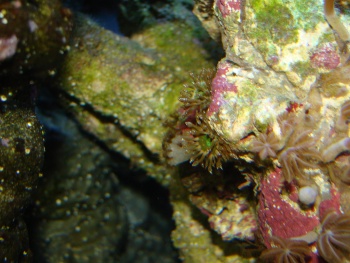
By Bob Goemans


Not Reef Tank Suitable
Not Suitable for Fish-Only Tank
Those in the Family Aiptasiidae, Genus Aiptasia, as quite problematic, as is the species Anemonia manjano in the Family Actiniidae.
As for the small brown rock/glass Aiptasia anemones described below, their sting can cause most corals to close-up and remain closed, and unfortunately they multiply quickly. The same is true for the manjano species.
Aiptasia pallida, A. pulchella, and A. diaphana all look alike to the layperson. See Aiptasia sp. for a general view of this species. They come from a wide range of localities and withstand a wide range of temperatures. Bottom line, it's the 'how to rid the aquarium of them' that is more important than 'how to maintain them!' Again, the same is true for the manjano species.
There are various ways to reduce and keep the Aiptasia population to a minimum, but there is no sure fire cure to rid the entire aquarium of this pest once it has gotten a foothold. If the hobbyist has a fish-only aquarium, they could introduce a Raccoon Butterflyfish (Chaetodon lunula), Klein's (Chaetodon kleinii), the Saddleback (Chaetodon ephippium), Tinker's (Chaetodon tinkeri), the Threadfin (Chaetodon auriga), or the Copperband Chelmon rostratus, which will eat these pests. Yet, should there be corals, feather dusters, star polyps or zoanthids in the aquarium, these fish will probably feast on them also.
Injecting it with boiling water or very hot Limewater (Kalkwasser) causes it to turn a grayish color, effectively killing the entire specimen. Also, readers have recommended injecting lemon juice as an effective way to kill them! This is probably the best approach for the manjano species. Yet, sticking a needle into the anemone before it can withdraw is almost impossible. Locating a hypodermic syringe filled with hot Limewater about a quarter inch away from the anemone and shooting a stream of hot Limewater upon the anemone stuns it and seems to prevent it from withdrawing/shrinking in size. It is then fairly easy to get the point of the needle into the still erect body, then injecting it, effectively killing the specimen.
For the Aiptasia anemones, another approach is using the sting from an Elegance coral (Catalaphyllia jardinei) to kill the anemone. This does work, as I have tried it! Another way to destroy these pest anemones was brought to my attention by a fellow hobbyist in New York. He notes that a slush mixture of sea salt deposited directly on the anemone will cause it to immediately die. Simply take some aquarium sea salt and make a slush-like mixture and flow it directly on the anemone. A syringe is a good way of applying this mixture. It can also be flowed into cracks getting it down to where these pests may have a foothold.
The Nudibranch Berghia verrucicornis, native to the Caribbean and western Atlantic, only feeds on Aiptasia anemones. Juveniles measure about 1 cm, with adults reaching 3 cm within a couple of weeks. They are nocturnal. Unfortunately, once these pest anemones are eliminated, the nudibranch will die because of a lack of food supply. Of course, you could pass it along to a fellow hobbyist who has some of these pest anemones. This way, the nudibranch may still be available should they return to your aquarium in the future. Also, other nudibranchs that may be effective are Spurilla neopolitana and Baeolidia nodosa, however, their availability is questionable.
A recent biological control is thought to be the Red-legged hermit crab, Dardanus megistos. This small hermit appears to be safe in reef aquarium and is thought to dine on this pest anemone. Yet more than an occasional positive feedback is still needed to confirm its usefulness.
Another biological control is through the use of Lysmata wurdemanni, usually called the Peppermint Shrimp. This 2.5 inch (6 cm) shrimp has lengthwise lines of red covering a somewhat transparent body. It does not have claws like the Banded Coral Shrimp, however is an effective killer of Aiptasia anemones. However, they appear to also consume Yellow polyp anemones.
Scats (Scatophagidae), which are a brackish and/or freshwater fish, are also a very good consumer of Aiptasia anemones. They not only take a wide variety of foodstuffs, including copious amounts of vegetable matter, they also like these rock anemones.
Another possible solution is the use of a little known Filefish, Acreichthys tomentosus. It is said to be reef safe, yet most filefishes are far from reef safe. Caution is advised.
Novel approaches such as the use of peppery hot sauce is not recommended, nor is chemicals such as hydrogen peroxide, hydrochloride acid or copper compounds. Other products claiming easy eradication of these pest anemones are to be tried and if you have comments about them, please contact me so I can post them here.
Without a doubt, disposing of any of these pest anemones when first seen, is the way to go!
And there are others that you should be aware of that are also not suited for the home aquarium, such as those mention in the Genus Bartholomea, e.g., Curleycue/Ringed Anemone and Knobby Anemone. I've also added some rarely seen stinging anemones/odd-balls just for the sake of divers that may come near them, as they are not collected for the trade.